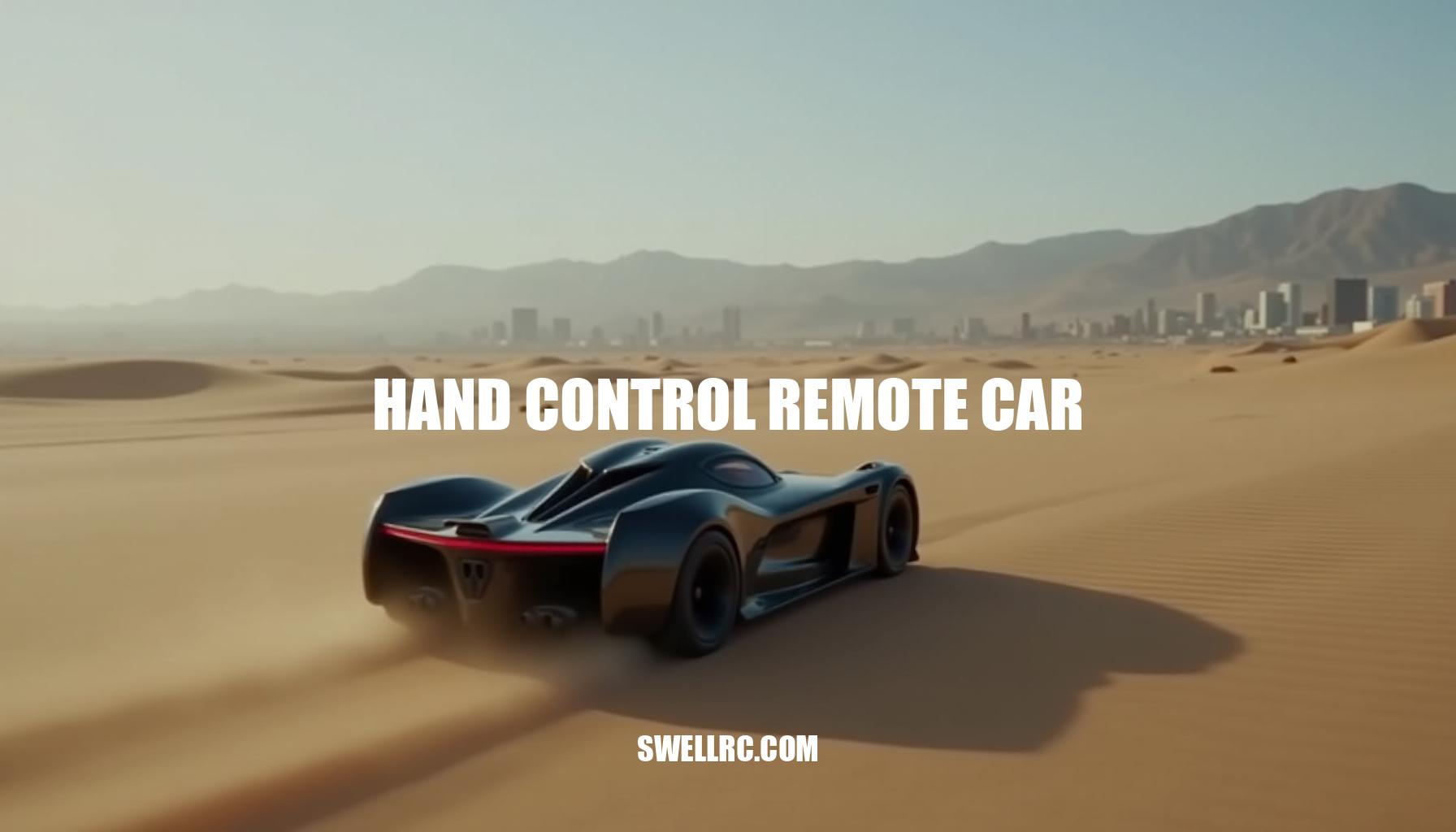Mastering Hand Control Remote Cars: The Future of RC Driving
The first time I tilted my wrist and watched the car arc smoothly through a corner, I couldn’t stop grinning. The sensation was unlike any traditional remote-controlled car experience — it felt as if the vehicle was an extension of my own hand. This newfound freedom sparked a wave of curiosity: How exactly was this hand control remote car interpreting my every subtle gesture and turning it into precise motion?
Simply put, a hand control remote car is an RC vehicle guided by natural hand movements captured by wearable sensors—think of it as driving through intuitive gesture control rather than fiddling with buttons or sticks.
These gesture-controlled vehicles decode your wrist tilts, finger waves, or even arm swings, translating them in real-time to navigate and speed up your remote-controlled cars with unmatched responsiveness.
From the earliest hobby experiments to the first commercial breakthroughs (see the first remote control car), control has constantly evolved, pushing the boundaries of what smart RC systems can achieve.
This isn’t just another toy—it’s the next level of RC evolution, blending technology and tactile play into an exhilarating driving experience that will forever change how you command your remote-controlled cars.
Understanding Hand Control Technology: The Science Behind the Gesture
Think of your wrist or hand-worn controller as a digital balance board—every subtle lean and twist translates into driving cues that guide your RC car with precision and ease. At the heart of this intuitive control lie accelerometers, which detect tilt and linear movement, capturing the direction you lean your hand. Complementing them are gyroscopes, sensors that measure rotational movements and help stabilize the signal, making sure your steering or stunt commands are smooth and deliberate.
These two sensors don’t work in isolation; instead, they feed data into sophisticated sensor fusion algorithms. By blending accelerometer and gyroscope inputs, sensor fusion filters out noise and erratic motions, providing clean control that adapts to your unique movement style over time. Many RC cars themselves also benefit from on-board stabilization systems for enhanced performance—for deeper stability insights, see RC car gyro technology.
Once the controller converts your nuanced hand gestures into commands (such as tilting your hand to steer or twisting your wrist to throttle and perform stunts), these signals are transmitted wirelessly via 2.4 GHz or Bluetooth technology to your car’s receiver. Thanks to ultra-low latency—typically around 10–30 milliseconds—your car responds almost instantly, creating a seamless and immersive driving experience.
Below is a simple visual diagram idea to imagine how this works: hand tilt controls the steering angle, while wrist rotation manages throttle or stunt maneuvers.
[Diagram suggestion: illustration showing hand tilted left or right mapped with arrows to car wheels turning, plus wrist rotation arrows mapped to throttle/stunt icons]
To give a clearer sense of how this compares to traditional RC remotes, here’s a quick look at hand gesture car control vs. standard remotes:
| Feature | Hand Gesture Remote Car | Standard Remote |
|---|---|---|
| Responsiveness | Very high (10–30 ms latency) | Moderate to high (varies) |
| Precision | Adaptive sensor fusion enables smooth, nuanced control | Button and stick-based, less subtle |
| Fatigue | Lower, natural hand movements reduce strain | Higher, repetitive pushing and twisting |
| Fun Factor | Engaging, immersive, intuitive gestures | Traditional, less interactive |
By seamlessly combining hand sensor remote car technology like accelerometers and gyroscopes with adaptive filtering and wireless transmission, your driving experience becomes not just fun, but also remarkably precise and reliable. This cutting-edge RC gyro stabilization and sensor fusion magic really takes your RC adventures to the next level!
Comparing Control Methods: Hand Control vs Traditional Remote
Switching from a traditional joystick to a wrist controller on the same RC track was a revelation. At first, maneuvering the RC car with the wrist controller felt a bit awkward compared to the familiar joystick. However, the fluidity of motion soon became apparent, allowing me to intuitively adjust speed and turns with subtle hand gestures.
On the other hand, the joystick offered precise control, especially during tight corners, which felt more mechanical but tremendously effective for racing lines.
To help you decide which RC car control style matches your skill, terrain, and play style, here’s a point-by-point breakdown based on my experience:
- Ease of learning: Wrist controllers have a gentler learning curve for newcomers; the natural hand movements feel intuitive, while joysticks require a brief adjustment period to coordinate throttle and steering precisely.
- Precision at low/high speed: Joysticks excel at ultra-fine precision driving, especially at high speeds, allowing subtle inputs that skate professionals appreciate. Wrist controllers perform wonderfully at moderate speeds but can feel less exact during rapid, sharp maneuvers.
- Fatigue over long sessions: Gesture controls reduce hand strain by leveraging natural wrist movements, leading to less fatigue during prolonged use. Joystick control can become tiring as gripping and thumb movements are more repetitive.
- Stunt capability: The dynamic nature of wrist controllers enhances stunt execution, letting you smoothly tilt and flick for flips and spins.
Joysticks offer reliable button combos but can feel more rigid.
- Accessibility for kids and newcomers: Wrist controllers are generally more accessible and engaging for younger users and novices, providing an immersive, fun introduction to RC driving. Joysticks might feel less intuitive initially but provide a stable foundation for serious racers.
If you’re new to throttle/steering basics, here’s how to control an RC car — a great primer before diving into either control style.
In summary, gesture control wins on immersion and fun, making every drive feel like a natural extension of your body. Meanwhile, traditional remotes still shine for ultra-fine racing lines and precision driving.
Ultimately, choose the control style that amplifies your joy and suits your terrain and skill level best.
Smart Integrations: Gesture, AI, and Universal Control Compatibility
Harnessing the latest in AI RC cars technology, AI-driven motion detection brings unprecedented precision and reliability to hand-controlled RC vehicles. This advanced system filters out noise and environmental interference, delivering cleaner, more accurate signals for seamless control even in the busiest settings. Coupled with Bluetooth RC connectivity, these cars offer hassle-free pairing and low-latency responsiveness, expanding your command range without the clutter of wires.
Central to this revolutionary control paradigm is gesture mapping, a customizable process where specific hand motions are assigned to functions such as steering, throttle, flips, or lighting effects. Whether you prefer a flick of the wrist to accelerate or a clench to trigger stunts, gesture mapping tailors the experience to your unique style.
Further enhancing flexibility, programmable remotes allow users to fine-tune settings like sensitivity and dead zones directly through intuitive firmware or companion apps. This adaptability ensures that beginner and expert pilots alike enjoy intuitive control without accidental inputs or lag.
Compatibility is a key advantage here. Many AI RC cars embrace universal remote compatibility, enabling seamless integration with a variety of transmitters. Explore universal options here.
Curious about mixing and matching components? Wondering if a different transmitter can run your car? Read this for helpful insights.
And when it’s time to get hands-on, see how to program a remote control to an RC car step-by-step.
Imagine integrating even more cutting-edge possibilities with your gesture-controlled car:
- Voice start/stop via your phone’s microphone for hands-free commands.
- Smartphone HUD overlays displaying real-time telemetry right on your screen.
- Geo-fenced speed limits—perfect for safe play areas, especially with kids.
- Custom stunt macros triggered by a quick double-tap for instant showmanship.
These features position gesture control not just as a flashy gimmick but as a genuinely customizable, future-ready way to engage with your RC cars. Combining AI-enhanced responsiveness, Bluetooth connectivity, and programmable remotes, the next generation of hand-controlled RC vehicles empowers you like never before.
Exploring Models and Innovations: From Wrist-Watch Cars to Gesture Twist Stunt Vehicles
Experience the revolution in RC categories where gesture-controlled technology transcends gimmicks to deliver thrilling, intuitive fun across diverse forms and scales. Whether you’re introducing young racers or indulging the most devoted tech tinkerers, there’s a perfect match designed for every enthusiast.
- Wrist-controlled cars: These compact wrist-controlled vehicles double as sleek wearables, featuring LED-lit controllers that respond swiftly to flicks and tilts. Their quick-learning curves make them ideal for kids and casual users eager to leap into hand control. See wrist-watch options.
- Gesture twist stunt cars: Unleash 360° spins, gravity-defying flips, and adrenaline-pumping sidewind modes with gesture twist stunt cars. Tunable motion sensors adapt sensitivity for teens and stunt lovers seeking precision and jaw-dropping tricks. Explore gesture-twist stunt types.
- Large-scale motion-controlled rigs: Command torque-filled, suspension-hardened, bash-ready remote control monster trucks that roar through rugged terrain. Designed for tech tinkerers and thrill-seekers craving scale and power, these beasts respond to complex wrist rotations, all while promising durability for endless outdoor action. Check motion-ready monster trucks.
| Category | Best For | Key Features | Value Delivered |
|---|---|---|---|
| Wrist-controlled cars | Kids, Beginners | Compact wearables, intuitive LED gestures | Durability, quick learning curve, engaging play |
| Gesture twist stunt cars | Teens, Stunt Lovers | 360° spins, flips, sidewind; tunable sensitivity | Precision control, thrilling tricks, skill growth |
| Large-scale motion-controlled rigs | Tech Tinkerers, Outdoor Enthusiasts | Torque, suspension, bash-ready monster trucks | Powerful performance, rugged design, expansive fun |
Visualize the action: a close-up of a glowing wrist controller mid-gesture; a top-down shot tracing sharp drift arcs mapped perfectly to wrist tilts; and an outdoor monster truck caught frozen at the apex of a colossal leap with an overlay illustrating wrist rotation. This isn’t just remote control — it’s an evolved interaction, a vibrant design shift that puts you directly in command.
Advanced Tips: Programming, Modding, and Controlling via Computer
For advanced users eager to customize their gesture-controlled RC devices, learning how to program an RC remote with safe and practical steps is essential. Start by following this simple numbered roadmap to extend gesture control confidently without compromising safety:
- Bind the controller: Establish a secure connection between your RC device and the controller to enable communication.
- Calibrate neutral and limit positions: Ensure all sensor readings correspond correctly to neutral points and movement boundaries.
- Map gestures to channels: Assign specific gestures to control different channels or functions of your RC device.
- Set sensitivity and dead zones: Fine-tune how responsive the gestures are and define zones where minor movements are ignored to prevent unintended commands.
- Save profiles: Store your settings as profiles to switch between various configurations easily.
- Test failsafe modes: Validate built-in safety features to prevent accidents in case of signal loss or hardware failure.
- Iterate: Continuously refine your gesture tuning based on testing feedback.
When exploring computer-controlled RC integration, consider using a USB dongle or UART receiver connected to a microcontroller or directly to your PC application. Keep latency considerations in mind for smooth operation; low-latency connections ensure responsive control.
For a detailed overview, refer to the Guide to computer control.
Engage in insightful RC modding by implementing ideas such as swapping the default IMU for a higher-grade sensor to reduce drift and enhance accuracy, adding a soft wrist strap to boost stability during use, or creating stunt macros where a double-tap on the wrist triggers pre-set flips or tricks. These customizations elevate the user experience significantly.
Safety notes cannot be overstated: always verify voltage compatibility between components to prevent damage, keep antennas clear of obstructions to maintain signal integrity, perform bench-tests with wheels off the ground to avoid unintended movement, and meticulously document every firmware or hardware change to enable easy reversion if needed.
Conclusion: The Future of RC Driving in Your Hands
After countless hours of tinkering, I still feel that same spark every time a tiny wrist flick turns into a perfect corner. This journey into the future of RC has revealed so much more than just a new way to play—it’s about embracing intuitive control that feels natural and effortless. With gesture-based driving, every motion translates into precise action, offering serious precision like never before.
But the magic doesn’t stop there; the boundless customization enabled by smart RC systems invites every enthusiast to tailor their experience to their unique style and needs.
- Intuitive Control: Navigating your RC with natural hand gestures creates an immersive and user-friendly experience.
- Serious Precision: Enhanced responsiveness ensures every flick and turn is executed flawlessly.
- Boundless Customization: Smart RC systems open doors to endless personalization, adapting to your driving preferences.
As we stand at the crossroads of RC innovation, one thing is clear—the thrill of control is no longer about buttons—it’s about motion itself. Dive into SwellRC and explore a world where your gestures become the ultimate command, unlocking an entirely new dimension of racing excitement.
Frequently Asked Questions
- How do hand control remote cars detect gestures?
They use motion sensors—mainly accelerometers and gyroscopes—inside a wrist or hand-worn controller. Sensor fusion software combines tilt and rotation data, filters noise, and converts your movements into channel signals that the car’s receiver understands. - Are gesture or hand-controlled RC cars better than traditional joystick ones?
It depends on your goals. Gesture control wins on immersion, quick learning for newcomers, and stunt play; traditional remotes often deliver finer, repeatable precision for racing lines. Many hobbyists keep both and switch based on the session. - What’s the difference between wrist-controlled and standard remote-controlled cars?
Wrist-controlled systems map your hand motions directly to steering and throttle for a more natural feel. Standard remotes use sticks or triggers, which can be more precise for tiny adjustments but feel less intuitive for casual driving and stunts. - Can I use any remote with a different RC car?
Not always. Compatibility depends on protocol (e.g., specific 2.4 GHz systems), receiver bindings, and channel mapping. Universal or alternative remotes can work if they support your car’s protocol and are properly bound and configured. - What’s the best way to program a hand control remote car?
Start by binding the controller to the receiver, run calibration for neutral and endpoints, then map gestures to channels. Adjust sensitivity and dead zones, set a failsafe, and test in small increments so you can quickly undo changes if needed. - How accurate are motion sensors in RC cars?
Modern IMUs are very accurate for hobby use, especially with gyroscopic stabilization and filtering. Expect low-latency responses and stable control, with occasional drift minimized by calibration and quality hardware. - Is there a learning curve to using a gesture-based RC car?
Yes, but it’s short for most people. Within a few minutes, basic steering and throttle feel natural; mastering tight lines or complex stunts takes practice, just like with sticks. - Can I control my RC car using a computer or smartphone?
Yes. With compatible receivers, USB/Bluetooth dongles, or companion apps, you can route control through a computer or phone. Expect to configure latency, channel mapping, and safety failsafes before driving.



